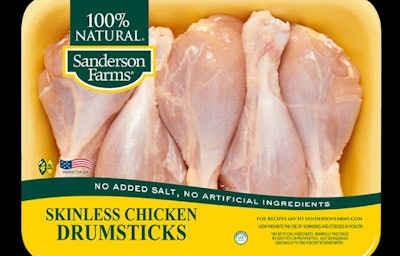
Sanderson Farms reported results for its second fiscal quarter and six months ended April 30, 2020.
Net sales for the second quarter of fiscal 2020 were $844.7 million compared with $845.2 million for the same period a year ago. For the quarter, the company reported net income of $6.1 million, or $0.28 per share, compared with net income of $40.6 million, or $1.83 per share, for the second quarter of fiscal 2019.
Net sales for the first six months of fiscal 2020 were $1.668 billion compared with $1.589 billion for the same period of fiscal 2019. The net loss for the first half of the fiscal year totaled $32.5 million, or $1.48 per share, compared with net income of $22.8 million, or $1.03 per share, for the first six months of fiscal 2019.
Results for the second fiscal quarter of 2020 include a net discrete income tax benefit of approximately $37.4 million related to the net operating loss carry-back provisions allowed by the CARES Act, which became law during the second fiscal quarter. Excluding this discrete income tax benefit, the Company’s net loss for the second quarter of fiscal 2020 was $31.3 million, or $1.43 per share.
“These are challenging and unprecedented times for all of us,” said Joe F. Sanderson, Jr., chairman and chief executive officer of Sanderson Farms. “I am especially proud of the dedicated work and perseverance of our 18,000 employees, contract poultry producers, customers, vendors, consumers who buy our products and the communities and states in which we operate. Our facilities have continued to operate normally because those who support our ability to continue to produce and deliver safe, high quality and affordable chicken products during this crisis have risen to the challenge, and I am very grateful for that. We are also grateful for the healthcare professionals and first responders across this country who are working tirelessly to protect the health of all of us.
“Protecting the health and safety of our employees has been our top priority from the beginning of this crisis. When it became evident in late February that we were facing a crisis of then unknown proportions, we consulted with various health care professionals, including infectious disease specialists, epidemiologists and others to determine steps we should take to mitigate the spread of the disease. With the input of these health care professionals, our COVID-19 Response Team developed a comprehensive list of measures and protocols designed to protect the health, safety and welfare of our employees and their families. The team meets twice daily to discuss the day’s activities and to monitor the effects of the virus on our employees, growers, customers and operations. Health and safety will continue to be our top priority as we manage through this crisis.
“The financial results for our second quarter of fiscal 2020 reflect the impact of the extraordinary challenges caused by the COVID-19 pandemic. The unprecedented social and economic impact of the virus and the related government actions to contain its spread materially affected every aspect of our business, including our labor force, sales, operations and production levels, as well as our customers. Sanderson Farms entered this crisis with and continues to have a strong financial position, little debt and ample liquidity. The company had $776.9 million of borrowing capacity available under its revolving credit facility at the end of the second fiscal quarter.
“The market volatility caused by this event is reflected in the market prices for boneless breast meat produced at our plants that target food service customers. Quoted market prices for boneless breast meat began moving seasonally higher in late February, and reached $1.35 per pound during the fourth week of March. Less than one month later, the quoted market price was at an historic low of $0.74 per pound, with some realized prices below $0.50 per pound. However, prices began to move higher at the end of April, as certain parts of the country began to relax restrictions to mitigate the spread of the virus and moved to $1.58 per pound by mid-May. The current quoted market price for boneless breast meat is $1.31 per pound. Our average sales price per pound of fresh and frozen poultry decreased 8.3 percent during the second quarter of this fiscal year compared with the same period last year and was lower by 2.5 percent through the first half of this fiscal year compared to the first half of last year.
“Demand for our products shifted among our customer base during the quarter, as orders from food service customers declined dramatically due to widespread closures of restaurants and other venues where food is consumed away from home, while orders from our retail grocery store customers surged. We were able to shift production from our food service program into our retail program to some extent, but overall, we processed 4.2 percent fewer pounds during the second quarter than we expected when we announced our first quarter results on February 27, 2020. Moving into our third fiscal quarter, we have reduced egg sets relative to our expectations, and we now expect to produce 5.9 percent fewer pounds during our third fiscal quarter than we projected in February, as we shift production into our retail grocery store program and reduce production levels at our plants that process a larger bird for food service customers.”
According to Sanderson, overall realized prices for chicken products sold to retail grocery store customers remained relatively strong during the second quarter and volumes reflected the surge in demand caused by consumers cooking more meals at home instead of going to restaurants and bars. On the other hand, commodity quoted markets for products from the Company’s food service plants were lower across the board. Compared with the second fiscal quarter of 2019, quoted boneless breast meat market prices were approximately 18.2 percent lower, the average market price for bulk leg quarters decreased approximately 7.8 percent, and jumbo wing market prices were lower by 23.1 percent. Market prices for chicken breast tenders averaged 29.0 percent lower than a year ago. The company’s average feed costs per pound of poultry products processed decreased by 1.1 percent when compared with the second quarter of fiscal 2019, while prices paid for corn and soybean meal, the company’s primary feed ingredients, increased 2.8 percent and decreased 1.3 percent, respectively, compared with the second quarter of fiscal 2019.
“Looking ahead to the second half of the fiscal year, we continue to expect prices paid for feed grain to be lower for the year compared to fiscal 2019,” added Sanderson. “There are ample supplies of both corn and soybeans worldwide, and the pandemic has had a material impact on demand for feed grain, especially corn used for ethanol. Planting progress for corn stands at 88 percent this week, well ahead of last year’s weather-delayed planting season, when progress at this time of the year was at 58 percent. At the same time, 65 percent of the soybean crop has been planted, versus a five-year average of 55 percent and 26 percent last year. Planting conditions have been favorable, and the USDA’s most recent estimates project corn production at a record 16 billion bushels on trend line yields. Had we priced all of our fiscal 2020 feed grain needs at yesterday’s Chicago Board of Trade closing prices, cash paid for feed grains during fiscal 2020 would be lower by $49.1 million during fiscal 2020 compared to fiscal 2019 using fiscal 2019 volumes. We estimate those lower costs would lower feed cost per pound of poultry processed during fiscal 2020 by 0.69 cents per pound.
“With respect to chicken production numbers, the USDA reports that broiler egg sets and chick placements in the United States have trended materially lower in recent weeks in response to the sharp decline in demand in food service markets caused by the pandemic. The current USDA forecast is for United States broiler production during calendar year 2020 to decrease approximately 0.29 percent compared to calendar year 2019. Given the reduction in planned production at our food service plants for the balance of the fiscal year, we expect our total production during our third and fourth fiscal quarters of 2020 to be up 2.2 percent and down 5.0 percent, respectively, compared to the same quarters of fiscal 2019.
“Among other measures taken to manage through the current environment, Sanderson Farms announced on March 31, 2020, that, effective immediately and continuing to June 26, 2020, all hourly employees who work their scheduled hours are eligible to earn an attendance bonus of $1.00 per hour. In addition, steps we have taken to protect the health, safety and welfare of our workforce and to address other challenges of this pandemic will increase our operating costs and negatively affect our volumes for the remainder of fiscal 2020. We anticipate these lower production rates and higher operating costs will continue until the effects of COVID-19 on our company, our customers, our employees and the communities in which we operate diminish,” Sanderson concluded.

















